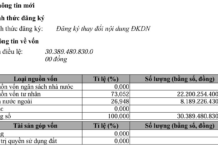
Deputy Prime Minister Tran Hong Ha requested the Ministry of Construction and the Ministry of Transport to continue reviewing and clearly defining their functions and tasks based on the mission of the new ministry, thereby designing an appropriate organizational structure to ensure effectiveness, efficiency, and performance. – Photo: VGP/Minh Khoi
Merger Should Not Be Mechanical; Instead, It Should Be a Combination of Strengths
On December 17, Deputy Prime Minister Tran Hong Ha worked with the Ministry of Construction, the Ministry of Transport, and several related ministries and agencies on the proposal to merge the Ministry of Construction and the Ministry of Transport. He emphasized that the goal of merging the two ministries must align with the directions provided by the Central Steering Committee for the implementation of Resolution No. 18-NQ/TW and the Government’s Steering Committee. The process should be scientific, with quantitative criteria that are convincing, comprehensive, objective, transparent, and impartial.
This is a significant, challenging, and sensitive task. However, the two ministries have successfully organized and achieved a high level of consensus among their leaders, Party Committees, and units, adhering to the spirit of the Central Steering Committee and the Government’s Steering Committee. The mindset of officials, civil servants, public employees, and laborers remains relatively stable.
Emphasizing the principle of “merger should not be mechanical; instead, it should be a combination of strengths,” the Deputy Prime Minister requested the leaders of the two ministries to continue reviewing and clearly defining their functions and tasks based on the mission of the new ministry. Consequently, they can design an appropriate organizational structure to ensure effectiveness, efficiency, and performance, adhering to the principle of “matching tasks with organizations.”

Minister of Transport Tran Hong Minh speaking at the meeting – Photo: VGP/Minh Khoi
Restructuring the Apparatus and Personnel: “Preventing Brain Drain and Talent Waste”
The Deputy Prime Minister stressed, “The groups with intersecting, overlapping, and duplicate functions and tasks must be rearranged according to the principle of ‘one organization can perform multiple tasks, but one task cannot be assigned to two organizations.'”
Additionally, the new ministry, following the merger, needs to streamline its apparatus and organization to effectively perform the functions and tasks that were previously lacking or those that have been added to align with the new mission and goals, as stated by the Deputy Prime Minister.
He also requested that the two ministries closely coordinate with the Ministry of Home Affairs to develop clear policies and criteria for evaluating the qualifications, capabilities, experience, training, and retraining of officials, civil servants, public employees, and laborers when rearranging the apparatus and personnel. This collaborative effort aims to “prevent brain drain and talent waste.”

Minister of Construction Nguyen Thanh Nghi speaking at the meeting – Photo: VGP/Minh Khoi
The New Ministry After the Merger Must Demonstrate a More Robust Reform Mindset
At the meeting, Minister of Transport Tran Hong Minh provided information about the joint work between the two ministries regarding the orientation for the restructuring, rearranging, and merging of the two ministries. The two ministries are meticulously reviewing to unify the implementation plan, aiming for a streamlined, effective, and efficient apparatus that meets the requirements and tasks of the new era.
Minister of Construction Nguyen Thanh Nghi affirmed that the merger proposal between the two ministries closely follows the general direction and the guidance of the Central Steering Committee and the Government’s Steering Committee. The merger proposal is based on the functions and tasks of the ministries, focusing on a meticulous review of the intersecting, overlapping groups of functions and tasks to streamline and merge them scientifically, not mechanically. Additionally, it involves reorganizing the management apparatus in some specific fields.
According to the preliminary assessment of the joint Steering Committee between the two ministries, the merger proposal fundamentally meets the requirements set by the Central Steering Committee, the Government’s Steering Committee, and the General Secretary.
“The two ministries have defined the tasks and operations of the new ministry after the merger. The leaders of the two ministries are continuing to address the difficulties and obstacles in the field of economic construction management and the operations of some directly affiliated enterprises,” said Minister Nguyen Thanh Nghi.
The Deputy Prime Minister stated, “The new ministry after the merger must demonstrate a more robust reform mindset, with a unified, consistent, and comprehensive vision in planning, standards, and norms for the technical infrastructure of various economic and social sectors (transportation, industry, agriculture, energy, telecommunications, water supply and drainage, etc.) nationwide, as well as in planning the development of urban and rural systems.”

Deputy Prime Minister Tran Hong Ha working with the Ministry of Natural Resources and Environment and the Ministry of Agriculture and Rural Development on the morning of December 17 – Photo: VGP/Minh Khoi
Urgently Complete the Merger Proposal Between the Ministry of Natural Resources and Environment and the Ministry of Agriculture and Rural Development
On the same day, at the Government Headquarters, Deputy Prime Minister Tran Hong Ha chaired a meeting on the proposal to merge the Ministry of Natural Resources and Environment and the Ministry of Agriculture and Rural Development.
At the meeting, representatives of the ministries exchanged and discussed some differing opinions, delineating the functions and tasks of state management that may intersect, overlap, or be contradictory between the two ministries and sectors. This clarification aims to ensure unified, consistent, and comprehensive management of rural infrastructure, water resource management, disaster prevention, veterinary medicine, etc. They also discussed the tentative name of the new ministry after the merger and the proposal to ensure the unity, consistency, and efficiency of the apparatus, organization, and activities of the new ministry, from the central to local levels.
The Deputy Prime Minister highly appreciated the proactive and urgent approach taken by the leaders of the Ministry of Natural Resources and Environment and the Ministry of Agriculture and Rural Development. They have closely followed the direction of the Central Steering Committee and the Government’s Steering Committee on the implementation of Resolution No. 18-NQ/TW in developing the merger proposal to reduce overlapping, contradictory, or missing state management tasks. Additionally, they have worked to build a scientific, streamlined, effective, and efficient apparatus to better meet the requirements and tasks of state management in the new era.
The Deputy Prime Minister requested that the leaders of the two ministries coordinate with the Ministry of Home Affairs and related ministries and sectors to continue reviewing and adhering to the spirit of “one person can do multiple jobs, but one job should not be assigned to two people” and “matching tasks with organizations.” This collaboration ensures unified, consistent, efficient, effective, and performance-oriented management. He also urged them to urgently complete the merger proposal between the two ministries before submitting it to the competent authority for approval.
Streamlining the Machine in Nghe An Province
The Provincial Party Committee Secretary and Chairman of the People’s Committee of Nghe An Province, Nguyen Duc Trung, has instructed leaders of agencies, units, and localities to take proactive and decisive action in streamlining their organizational structure and machinery, especially for sectors involved in mergers and consolidations.
Streamlining Ho Chi Minh City’s Government: Reducing 8 Departments and 5 Administrative Bodies
As per the announcement by the Ho Chi Minh City Party Committee Organization, the city has successfully streamlined its administrative apparatus by merging and reducing the number of departments. This bold move has resulted in an impressive reduction of 8 departments and 5 administrative bodies, aligning with the central government’s directives.












































